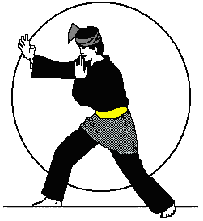
 This page is still under construction.
This page is still under construction.
Dated: April 1998.
Posted in April 1998.
|
Mental Training is relatively new in Silat. Most of the older masters do not have a clue as to its usefulness. Many silat exponents, young or old, considers mental training to be hocus-pocus. "How can telling yourself you can win actually helps you win?", they say. This is one of the reasons why I wrote a whole article on my findings in mental training in detail and put a link to it on this page so that the reader can read and understand how I come to believe certain things. It also allows the reader to make his own decisions on the validity of mental training for martial arts in general. If the reader chose not to believe in the ideas presented here, then it is alright. But I urge the reader to at least read the article on mental training before jumping to any conclusions. Basically, my mental training exercises include:
|
Posted on 4th January 1999.
|
There is an old Chinese saying; 'A fighter is as good as his body.' Or something like that! Anyway, it is important to keep the body in shape if one wants to get anywhere in martial arts competition fighting. A lot of things can happen before a fight. You might catch a flu, fall sick, feel sleepy due to not enough sleep, the list goes on. You can't eliminate all the dangers. Nevertheless, you still better off in the ring if you have a body like Sylvester Stallone rather than Pee Wee Herman. For advice on actual physical fitness, there is a link in this section elaborating on that subject.
For all those 'things that can happen before a fight', I have a few rules that I adhere to to stay healthy:
|
Posted on 10th June 1999.
|
The concept of "Distancing" in wiralaga refers to the distance between an exponent and his opponent. It touches on how the distance between the two fighters can determine the outcome of the fight.
Actually, to me the main concept of distancing in wiralaga is quite simple. There are only two ranges; close range and long range. When I fight, I always stick to this rule; when he's in close range, I punch-When he's in long range, I kick. It makes life a lot simpler. Of course, that's only the main concept of distancing. There are, of course, other aspects on distancing which deserve greater attention, which is why I wrote an article on it. At the time of writing it may not be fully complete; I may decide to add in things that I recalled in the future. As for now, it's seems quite okay. Anyway, if you have any comments, do let me know.
|
Posted in April 1998.
|
Silat is unique from other similar martial arts in its category. Along with the usual punching and kicking, it has takedowns. Some people call them silat throws, but I prefer the term 'takedown' because when people hear the word 'throw', they picture judo-like throws where the fighter actually grabs the opponent and swing him over the shoulder. Some silat throws are like that, but throws for competitions are usually takedowns, or tripping if you like. Those that are good in takedowns are usually the champions in silat fighting. There is a reason for this. Consider this scenario; a silat fighter kicks his opponent squarely on the abdomen. Both fighters are at the center of the ring (small white circle). Each has fighter is backing a juror (refer to the article on 'The Gelanggang'). The 3rd juror is on the right or left of the fighters, depending on which fighter we are refering to. The kick, theoretically, will score 2 points from the three jurors. But the only juror that will give the 2 points may be the 3rd one. This is because the other two jurors may not be able to see the kick. It is blocked from view by the two fighters. Even if they hear a hitting sound they still may not give the 2 points. They only trust visual confirmation. Incidentally, it is said that the Indonesian National silat fighter's training includes an approach to somehow overcome this deficiency in gaining points. They seem to have a formulae to better able the jurors to see their strikes. It involves (I think) positioning of the fighters during striking. Unfortunately, I have little information on the subject. If I gain any more information about this I'll put it here. Incidentally, the Indonesians are the 'giants' of silat fighting. However, the above is not true for silat takedowns. When the exponent throws his adversary, and the adversary falls, the wasit will stop the fight. He will then proceed to signal to all the jurors to award the exponent 3 points (3x3 jurors, to be exact). Due to this, there is no such thing as not seeing the technique for takedowns. If the wasit is not satisfied that the takedown is successful, he will not award the points. So, it's either you get it or you don't. Thus, those that are good at takedowns (or throws if you like) tends to get more points from the jurors. That's why these fighters are usually the champions in any silat tournaments.
|
|
www.Cari.com.my |
 www.infoseek.go.com |